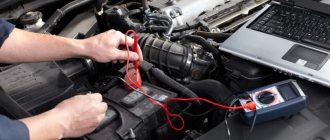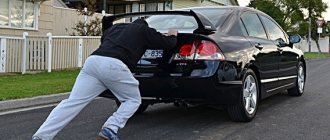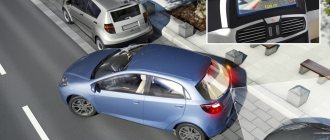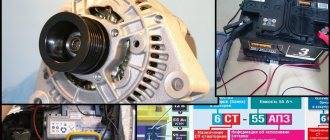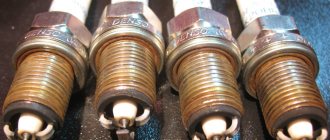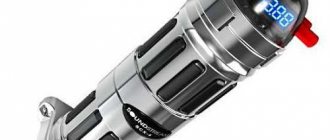Winter tests the strength of both the car and its owner. Frosts, snowfalls, long nights - these and other difficulties cause an increase in the number of accidents. But you can, on your own, simply and inexpensively, reduce the influence of uncontrollable elements on you. No Ministry of Emergency Situations will help you as much as you can help yourself. Find out from this article what to do about the body and its equipment of the VAZ-2107 to make driving more comfortable and safer in winter.
Lubricate rubbing parts
Door locks, trunk and hood, their hinges, glass guides - this is a list of what needs to be lubricated. As a lubricant, it is convenient to use silicone grease in an aerosol can or, everyone knows, VD-40.
It is better to lubricate the glass guides with silicone grease. Lower the windows down and thoroughly saturate the guide fabric with lubricant. Lower and raise the windows several times to distribute the lubricant. Try not to let the grease get on the windshield. A thin tube is attached to the can. Use it to avoid splashing everything around.
To prevent the doors from freezing to the seals, they (the seals) can be treated with silicone grease.
Lubricate the hinges and door locks with a small amount of WD-40. Open and close the doors several times to distribute the lubricant. Repeat these steps. Don't forget to inject lubricant into the door and trunk lock cylinders.
The windshield must be intact
Cracks and chips in the windshield prevent the driver from keeping an eye on the road even in summer. In winter, when daylight hours are shortened, they can create serious problems. The headlights of oncoming cars, the taillights of passing cars, and traffic signals are distorted and refracted in cracks. As a result, you see something that is not what really is. There is one step left before an accident.
Replace your windshield if cracks or chips make it difficult to see the road. Remove toys, pendants, fringes, etc. Anything that interferes with the view should be removed. By doing this you will help yourself avoid trouble, and maybe save someone’s life!
Changing windshield wiper blades
The rubber bands of the brushes wear out very quickly, and they are not expensive. Make it a rule that brushes need to be replaced before the winter season. A clean and intact windshield will provide you with a clear view.
Checking the washer
The slush and dirt on the road does not end all winter. The wheels of the cars lift it all into the air and throw it onto your car. Helping the wipers clean off dirt is the job of the washer. In its system, we check the integrity of the tank and pipes, the operation of the injectors and pump. If necessary, we adjust the direction of the jet and replace damaged parts. Before the onset of sub-zero temperatures, fill in the “anti-freeze” and pump it until it comes out of the nozzles.
Checking the light
Do you like being blinded by oncoming cars? Hardly. How long ago have you checked the headlights of your own car? Let's check it out right now.
To do this, stop where there is more space, so that nothing blocks the front of the car. Remove the headlight protection, if present. Turn on your low beams and look at their light from ten to twenty meters. The same must be done with three passengers in the back seat. You see, even the low beam began to blind. Find the headlight leveling control knob and turn it to the “full vehicle load” position. Now look at the headlights again. If everything is in order, then in low beam the headlights noticeably lower and stop blinding. All you have to do is remember the corrector at the right time and turn it to the desired position.
It’s much worse when you find that one headlight, for example, shines downwards, the other up and to the side... This happens after replacing headlights due to broken glass. On VAZ-2105, VAZ-2104, VAZ-2107 and their modifications, headlights are easy and convenient to adjust. Of course, if possible, it is better to contact the service. There is equipment there and they will do everything right. But you can also adjust the headlights yourself, even if not perfectly. To do this you need a flat area and a wall. Place the car five meters at a right angle to a vertical wall and turn on the low beam. You will see spots of light on the wall. Look at the picture, this is what the ideal light distribution looks like.
Screen diagram for adjusting the low beam of VAZ-2107 headlights
Now look under the hood and find the adjustment screws. Screw 1 deflects the light up and down, and screw 2 to the left and right.
Screw 1 turns the headlight up - down, screw 2 left - right
By alternately adjusting the left and right headlights, try to obtain light spots as in the figure.
You won’t believe it, but oncoming drivers will be very grateful to you after these adjustments!
Cleaning drainage and jack sockets
To prevent water from accumulating in the cavities of the thresholds, each of them has two drainage holes. Find and clean them. Clean the jack sockets so you don't have to worry about installing the jack in winter.
Let's warm ourselves up
“Classics”, of course, are eternal. But rubber door seals, over time, age and begin to leak air. On cars with significant mileage, a lot of heat escapes through leaks in doorways. What should I do?
Buy and glue additional seals. They are available in parts stores. You can find suitable seals at building supply stores.
In severe frosts, standard thermal insulation under the feet of the driver and passengers is not enough. Therefore, many people place sheets of isolon or another material with similar properties under the rubber pads.
Frost is not scary
If you do all the work described above in the fall, your winter will become a little lighter and warmer. Good luck on the roads!
According to the natural laws of nature, the sun and warmth are replaced by rainy autumn, followed by a snowy, frosty winter, and with it sad thoughts about the fate of the car. What should I do? Standing or driving - “that is the question.”
The combination of various conditions: time of year, operating experience, the presence of a garage and others makes it possible to build many combinations, each of which has its own nuances. However, the most difficult period in terms of operating conditions is the winter period, so we will focus on it.
Car storage in winter
Winter. Until better times, the car is located in an open paid parking lot. Many, especially young car enthusiasts, carefully wrap their cars in the hope of somehow making the winter easier for their “pet.” An experienced car enthusiast will not do this. It must be remembered that even in winter the sun often shines, the temperature sometimes rises significantly above zero and then under the tarpaulin (or, even worse, under the film) a “steam room” is created, figuratively speaking, which is much more harmful than dense snow cover. Of course, in this situation, you can find a “Solomon” solution, i.e. protect the car from snow and rain using the same materials, but covering the car with them so as to imitate an awning or tent, i.e. ensure air circulation between the car and a blanket.
You can do this yourself by installing small (20-25 mm) spacers on the roof, doors and wings, which are easiest to attach to suction cups.
If you want the seasonal “dwelling” of your car to look presentable, purchase an awning with a frame, the production of which has been mastered by the industry. Such a lightweight garage will protect the car from rain and snow drifts.
Preparing the car for winter hibernation
When preparing a car for winter storage, either in an open parking lot or in a cold, unheated garage, it is very useful to place the car on four blocks, which should be installed under the bottom of the body in the places recommended in the car’s operating instructions, so that the wheels do not touch the ground. We also advise you to reduce the tire pressure to 0.5 kgf/cm2. These operations will unload the car's springs and provide the tires with a normal winter.
It is advisable to turn out the spark plugs and pour 30-50 grams of oil used for the engine lubrication system into the spark plug holes of each of the four engine cylinders. In this case, it is recommended to close the spark plug holes with wooden plugs. After completing this operation, it is necessary to turn the engine crankshaft two or three turns so that the oil covers the surface of the cylinder mirrors with a film.
When all the “organs” of the car are resting, the battery is awake. In her, life does not fade away for a moment.
To keep your battery from dying, careful care and attention is required. Relax this attention, and you will have to look for the cause of her illnesses, of which there are quite a few.
What needs to be monitored so that the battery is always, in any weather, full of strength, energy and, at the first request, infects all the numerous organs of the car with its energy?
The plugs covering the filler necks have ventilation holes. These openings must always be kept clean. Gases must be removed through them and, if the holes are clogged, the gases look for other paths and eventually find them, at the same time swelling and destroying the mastic.
It happens that electrolyte splashes out through the holes in the plugs, and this is natural if you have filled it more than normal. There should be enough electrolyte so that it covers the plates and its level is 10-15 mm higher than the safety shield. Believe me, the battery will splash out all the excess electrolyte, and besides, “in the excitement” it can also splash out part of what is needed. As a result, the exposed plates become sulfated and the battery loses capacity.
Sometimes electrolyte splashes out even at normal levels. This is a symptom of another disease. This phenomenon occurs if the charging current is higher than normal. This disease is more complicated; you need to have a device and certain knowledge at hand in order to competently solve the problem.
It is very easy to discharge a battery (multiple engine starts, long-term connection of a portable lamp, sidelights left on at night), but restoring its lost power is sometimes more difficult. Therefore, care and attention are the key to her confident service.
Where and how to store the battery?
Now about storing batteries in winter. This question causes fierce debate among car enthusiasts. To shoot or not? Where to store: cold or warm? What monitoring and maintenance is required during long-term storage? It is impossible to answer all these questions unambiguously, since the storage method depends primarily on the “age” of the battery. It is better to keep new batteries with normal electrolyte density at sub-zero temperatures, but not below minus 20 °C. Under such storage conditions there will be virtually no self-discharge and water will not evaporate from the electrolyte. It must be remembered that at temperatures below minus 20 °C there are cases of mastic peeling off the walls of the monoblock, and therefore it is still safer to remove the battery from the car in order to prevent hypothermia. In the first month of storage, it is necessary to check the constancy of the level and density of the electrolyte 2-3 times. If you do not find any noticeable deviations from the norm, then you can rest assured during the entire period of “hibernation.”
For batteries “not in their first youth” (three years or more), storage conditions should be consistent with their age. The fact is that over time, lead sponge forms on the edges of the plates, the amount of sludge (oxidation products) increases at the bottom of the cans, and self-discharge increases sharply, reaching 3-4% of the battery capacity per day.
Naturally, such a battery requires an eye and an eye. An oversight can lead to self-discharge, a dangerous decrease in the density of the electrolyte, its freezing and ultimately to rupture of the battery case. As you can see, such batteries do not tolerate passive existence in frosty conditions. They must be removed and stored at above-zero temperatures, systematically monitoring and “correcting” health. Do not forget that the lower limit should be considered a density of 1.23 g/cm 3 at a temperature of +15 °C.
For reference, we provide a simple table of electrolyte density at different degrees of charge of the battery (see table below).
To avoid corrosion, coat all chrome parts with a protective varnish or lubricate them with a thin layer of oil (you can use engine oil for convenience).
Winter tires versus classics, which one to choose
Before the onset of winter, car owners often wonder which winter tires are best to choose for their Zhiguli. The winter period has always required drivers to prepare their vehicle. One of the main operations was “re-shoeing” the car with winter tires.
Features of winter tires for cars
Many people believe that the difference between tires designed for different seasons comes down to the tread, namely its design. This is partly true; the tread pattern of winter tires is different from that of summer tires. However, the main difference lies not in the tread, but in the rubber composition itself.
The fact is that at negative temperatures, rubber changes its properties - it becomes hard, while the quality of the grip of the “hardened” rubber decreases. In winter tires, the composition has been changed so that it remains soft even at low temperatures.
But this condition also has a negative role - such rubber becomes even softer at positive temperatures, which leads to the fact that driving the car becomes more difficult, it begins to float a little on the road. Additionally, winter tires are often equipped with metal studs to improve wheel traction on snow and ice.
equipped with spikes - another type of stingray is produced, without spikes. Popularly, such tires are called “Velcro” or “cobwebs”. The fine, specially applied tread of these tires provides reliable grip on winter roads even without the use of studs.
All-season tires, which are supposedly designed for both summer and winter cold, are also popular among people. This is not an entirely correct judgment; rather, these are tires for the autumn-spring period, since in summer they are not hard enough, and in winter they do not have the required softness.
So you shouldn’t take any chances, and in winter use only tires designed for this period.
So, now the market offers a large number of winter tires for cars, including for our automobile industry; winter tires are sold for VAZ classics, as well as the new generation - 21099, 2110-2114.
One of the significant conditions...
When choosing winter tires for a VAZ, the “wallet size” factor is considered. After all, a lot of companies, both domestic and foreign, are engaged in the production of tires.
But this criterion also has one underlying reason - often tires from European manufacturers are designed for their winters, where the temperature is higher than ours. As a result, expensive tires can perform much worse on the highway than inexpensive domestic ones.
To say unequivocally which winter tires are better for classics and which for other models -
impossible, since each driver has his own opinion. Some people like Nokan Hakkapeliitta, which are considered one of the best, while others are content with the domestic Rosava, and consider the tires of this manufacturer to be quite good. You can also note such companies as Hankook and Bridgestone, they also have tires that can be installed on VAZ. But in general, it all depends on the money available, as well as on certain preferences - “studded” or “Velcro”, with a symmetrical or directional pattern.
R13 or R14
Another important issue is the possibility of switching from standard R13 tires to R14. This issue is controversial; it comes down to tires rather than wheels. Since the disc size is larger, this affects the profile height. The lower the profile, the more the rubber will transmit road unevenness to the suspension, which will ultimately result in an increase in driving rigidity, but the car's handling will improve.
But if you take into account that the handling will improve slightly, but the possibility of damaging the disk itself or the slope on potholes will increase, then it is still better to use disks on the car assigned by the manufacturer. Many car enthusiasts in VAZs use R14 wheels in the summer, and in the winter they switch to R13, and stamped wheels.
Features of tires VAZ 2106-2107, VAZ-21099
So, let's look at which winter tires are best to use on certain VAZ models. First, let’s figure out which classic winter tires to choose. For these cars, the manufacturer recommends using tires with dimensions 165/70 R13 and 175/70 R13. As you can see, both tires have the same profile height, the difference comes down to the profile width. Therefore, winter tires on the VAZ 2107 are identical to those on the 2106.
As for manufacturers, there are a large number of them, but many owners use domestic ones - Rosava or Kama. They are not expensive, and their driving performance is quite good. The optimal winter tires for VAZ 21099 are 175/70 R13, however, as a replacement option, you can use 185/60 R14 wheels. Here you can see that the profile height of such a tire is smaller, which means the possibility of damaging the disk is greater.
On a note. Here are good prices for winter tires for classics
Features of tires VAZ 2110-2112, VAZ 2114-2115
But for the VAZ 2110-2112 family, tires of sizes 175/70 R13, 175/65 R14 and 185/60 R14 are considered standard, it all depends on the configuration of the car. At the same time, the best winter tires for a VAZ 2110 will be with the first two sizes, the latter has a low profile; it is better to purchase summer tires with this size. But in general, what size winter tires to install on a VAZ 2112 is up to the car owner to decide.
The VAZ 2114-2115 models also use the same tires as the VAZ 2110 family. Therefore, which winter tires are better for the VAZ 2115 is a matter of preference.
As you can see, there are no clear recommendations on which winter tires are better for the VAZ 2114 and which ones for the VAZ 2106. Many factors are taken into account here, such as financial capabilities, preference for certain tire features, even winter conditions influence the choice.
The only important condition is that you should definitely change the tires, but it’s up to you to decide which winter tires to buy for the Classic or the newer VAZ family.
Video - how to choose winter tires
remont-avtovaz.ru
Operating a car in winter
Let's look at the next option, possible in winter. Are you confident enough to drive a Zhiguli car in winter? Remember that driving a VAZ 2101-2107 in winter requires a lot of experience and skill. It is known: the design provides everything to make engine starting in winter as easy as possible. However, here too you need to adapt to your car and, of course, prepare it for winter operating conditions.
First of all, it is useful to replace the engine oil with winter oil while simultaneously replacing the oil filter, since at low temperatures the oil becomes viscous, which makes starting difficult, increases wear on working surfaces and increases fuel consumption. If the engine was filled with universal (all-season) oil, then changing it to winter oil is not advisable.
You should make sure that it is correct, since even a slight deviation from the norm in winter conditions will immediately affect the engine starting.
Considering that severe frosts exceeding minus 25 °C can suddenly “hit”, we advise you to use simple countermeasures that will make starting the engine easier. The operation is as follows: in the evening, when parking the car, turn off the ignition and pour in 0.3-0.5 liters of AI-92 gasoline through the oil filler hole (breather). Start the engine and let it run at low crankshaft speed for 1-2 minutes; in the morning, even in the most severe frost, the starter will easily “turn” the crankshaft. Practice has shown that such an event does not dilute the oil. Within 15-20 minutes, as the engine warms up, gasoline evaporates, and the vapors, passing through the crankcase ventilation system, are freely sucked into the engine cylinders, where they burn.
Battery: checking condition and charging
To facilitate starting, the “power” of the battery is very important. Therefore, do not be lazy to check the density and level of electrolyte in each battery and, if necessary, recharge the battery. By the way, we would like to remind you of two devices with which it is very convenient to control and recharge the battery at home.
In order to control the density of the electrolyte without spending a lot of time and labor, it is advisable to purchase a simple PE-1 device. The density meter consists of a plastic body with a tip and an aspirator. The body contains seven floats, calibrated for densities respectively: 1.19; 1.21; 1.23; 1.25; 1.27; 1.29; 1.31 g/cm3. On the outer surface of the body opposite each float is marked the nominal value of the electrolyte density at which this float and all previous ones float.
To determine the density of the electrolyte, you must: remove the plugs from all batteries; squeeze the rubber bulb of the density meter and lower the tip of the housing into the battery; take a sample of the electrolyte, drain it and take a new sample.
It is necessary to ensure that during sampling the instrument body is positioned vertically and the density scale is on the inspector’s side. To prevent the floats from sticking to the walls of the housing, tap the housing with your finger. The density of the solution in a given sample is determined by the last floating float. For example, when taking a sample, floats with the following values surfaced: 1.19; 1.21; 1.23; 1.25. Therefore, the density of the electrolyte is 1.25 g/cm3.
To avoid burns, do not allow electrolyte to come into contact with the skin of your hands.
After measuring the electrolyte density, rinse the inner and outer surfaces of the device with water. The device must not be washed with acetone, gasoline or other organic solvents. Dimensions of the device are 200x70x60 mm. Weight - 60 g. Scale division 0.02. Electrolyte density can be measured in the temperature range from minus 20 to plus 45 °C.
Charging the battery
To recharge the battery at home, you can use the Rassvet device, currently produced by industry, which combines all the best qualities of modern rectifiers and chargers. The name of the device may differ, so before purchasing an automatic charger, check its main characteristics with the sellers and preferably compare the models. In large auto stores you can choose a device that is right for you not only in all respects, but also in price, ranging from cheap Chinese options to expensive professional models.
An important advantage of the device is that you do not need to monitor it, and at the same time the battery. “Rassvet” is connected to a network with a voltage of 220 V, a battery is connected to it, and then everything happens by itself, since as the battery charges, the current automatically decreases. Thus, the battery can be automatically recharged during long-term storage. During the day, this unit will consume only two kopecks worth of electricity, but at any moment the battery is ready to get to work fully armed.
If you were unable to purchase the Rassvet device or its equivalent, use the simple and inexpensive design of a charger from one of the Moscow car enthusiasts. The device is used to “add” 20-22 Ah, wasted by the battery during operation, in 1-2 days.
The rectifier (see diagram below) is assembled from four diodes 2 of type D7 with indices D, E or F and a regular light bulb 1, which limits the charging current.
With a network voltage of 220 V and a 100 W light bulb, you will receive a charging current (flowing through battery 3) of about 0.5 A, and with a voltage of 127 V you will need a 60 W light bulb with the same current in the circuit.
To avoid freezing of the fuel pump valves, nozzle holes, and the formation of air locks, do not be lazy to blow out the power supply systems with compressed air. This not very complicated operation will subsequently save you from unexpected stops.
Brake adjustment and tire condition are extremely important for safe driving on winter roads. Braking of the right and left wheels should begin simultaneously, and the front wheels should be blocked later than the rear ones. It is necessary to monitor the tire pressure, which should be the same in the front and rear wheels, respectively. Otherwise, the contact area and grip on the road surface will be different, which can lead to skidding.
It goes without saying, don't forget to change your summer tires to winter ones!
To tell the truth, it is somehow immodest to give advice to a person who has firmly decided to drive a VAZ car in winter. However, there are very brave and impatient young car enthusiasts, and we recommend that they pay attention to other useful tips on our website, which will be useful not only when operating a car in winter, but all year round.
Warning
Daylight hours in winter are much shorter, so you will have to drive more at night, which is unsafe if you do not have stable skills.
| EXECUTION ORDER A serviceable car does not require winter preparation. For operation in the northern regions of the country and large cities, we can only recommend carrying out a series of control measures and special additional training to eliminate accidents. After all, as the famous satirist said, “... rattling keys in the cold is much more pleasant.” Additional preparation primarily includes unscheduled maintenance; it can be greatly facilitated by using modern automotive chemicals and special operating materials. Everyone understands the importance of a serviceable battery during winter vehicle operation. The electrolyte density of a fully charged battery may differ from the nominal one by no more than 0.02 g/cm 3 . When checking the battery with a special load fork, the readings of the built-in voltmeter should be 12.5–12.9 V with the load off and not drop below 11 V with the load for 10 s. Such a battery will serve for a long time and reliably. The most well-known battery brands are Bosch and Varta. We can recommend good batteries from the Turkish company Inci, the Spanish Tudor and the Czech branch of Varta, from the domestic Tyumen and Podolsk battery factories. When choosing a battery, pay attention to the following parameters: — capacity. In accordance with the operating instructions, it should be 55 Ah. It is allowed to use batteries with a capacity of 45–60 Ah. A capacity that is too small will create problems with “winter” starting the engine; if it is too large, the generator will not fully charge the battery and the battery life will be greatly reduced; — starter discharge current , A, according to DIN 43 539. The larger its value, the better, especially during winter operation. This ensures that the starter will turn the crankshaft at a high enough speed, and if the engine doesn't start on the first try, you'll have a chance to do a second and third instead of getting the tow rope. Do not purchase batteries from “southern” manufacturing countries: there are no frosts there, and their starter discharge current may be significantly less than that of batteries adapted to Russian winter conditions. If the battery is still “dead,” you can use “lighting” cables with alligator clips. When purchasing, it is better to choose cables designed for heavy loads (from 200 A). Using a less viscous winter engine oil makes it much easier to start a cold engine. The international classification SAE J-300 contains six classes of winter oils. “Winter” classes are designated by the letter W (winter). In temperate climates, it is permissible to use all-season (universal) motor oils in winter, which are now widely used. Of the domestic brands of motor oils, we can recommend such as “Rexol Universal”, “Rexol Super”, “LUKoil Standard”, “Norsi”, “Spektrol”, “Ufalub”; from imported ones - Castrol GTX, ELF-Sporty, ESSO Ultra Oil X ESSO or Super Oil X, as well as Shell Super Plus. However, when purchasing oils, especially imported ones, you should beware of counterfeits, so it is best to purchase oils in specialized stores that provide product certificates. Remember that during intensive city driving, changing the oil (and, accordingly, the oil filter) must be carried out in strict accordance with the factory operating instructions for the vehicle, reducing the replacement frequency by 20% every 50 thousand km starting from 100 thousand km. Flush the lubrication system when switching to another brand of oil. Various “boilers” that supposedly heat the thickened oil in the crankcase do not give any practical effect other than premature failure of the battery. The engine cooling system of the Volzhsky Automobile Plant uses special low-freezing liquids - antifreeze: aqueous solutions of alcohols, glycols, glycerin and inorganic salts with the addition of special additives. One type of antifreeze is antifreeze, an aqueous solution of ethylene glycol with additives. To prevent the liquid in the cooling system from freezing with serious consequences for the engine and engine and heater radiators, you need to check its freezing point. Recently, special hydrometers for antifreeze have appeared on sale, calibrated both in g/cm 3 and in degrees of freezing temperature. Temperature correction to hydrometer readings when measuring electrolyte density
Electrolyte density at 25 °C, g/cm3
Characteristics of winter oils
Temperature range of application of universal motor oils (according to SAE classification)
You can also add imported antifreeze. Due to a larger number of additives, imported antifreezes last longer and better protect the engine from corrosion. It is strictly prohibited to use water in the cooling system in winter. This is explained by the fact that when the heater fan is turned on at full power, the circulation of water through the radiator may completely stop and the water in the radiator will freeze while driving. When the car is stopped, there will be no circulation through the radiator and the engine will “boil”. Before starting winter operation, it is useful to fill the gas tank with a special additive, for example Gasoline Treatment from ABRO (USA), to remove water from the tank and the power system. Advice To make starting carburetor engines easier, a special starting fluid is also used, but this shortens the engine's life, since the liquid washes away the oil from the cylinder walls, which leads to dry friction of the piston in the cylinder at the time of start-up. The operating instructions require replacing spark plugs every 15 thousand km. But taking into account the experience of carrying out repair work, it is better to do this once a year, regardless of mileage, before the start of winter operation, or more often if the car is used very hard in a large city, or on gasoline of questionable quality, or the mileage per year exceeds 15 thousand km. It is better to use spark plugs from imported manufacturers: PAL (Brick), NGK, Bosch, Beru, Champion, etc., approved for use in engines of the 2108 family. Winter use, especially on the “salty” streets of big cities, greatly increases the corrosion of body parts. Regular washing in winter is necessary if the car is stored outside, and absolutely necessary every day if the car is stored in a warm garage. Water washes off salt well, and in addition, the “compress” of wet mud takes a very long time to dry, increasing the harmful effects of salt on the paintwork of the body. As a last resort, wash your car more often when it thaws, and before it gets cold, wash it and wipe it dry, ideally dry it in a warm room. Before starting winter operation, be sure to carry out additional anti-corrosion treatment of the body. This treatment is best carried out at a specialized car service center using special protective equipment and technologies. There are two types of anti-corrosion treatment: treatment of the bottom and hidden cavities of the body and treatment of the paintwork of the body. The latter can be easily done independently. It includes washing, drying and treatment with special protective compounds based, as a rule, on wax or silicone. We can recommend products from ABRO (USA): car shampoo with carnoba wax Wash-N-Glo, gold car wax with Teflon Car Wax Super Gold, silicone car wax Heavy Duty Silicone Cleaner & Car Wax. If, when processing the body, you find deep scratches, treat the exposed metal with a rust converter (modifier), for example, the domestic “Feran” or the imported Rust-Eater. Plastic fender liners reduce abrasive wear of the anti-corrosion coating on the inside of the wings, but if they are installed improperly, poorly ventilated cavities can form between the wing and the fender liner, in which additional pockets of corrosion will appear due to penetrating moisture. If you use studded tires, be sure to change them as a set, and do not, as some “experts” advise, limit yourself to only the front pair of wheels, as this sharply increases the likelihood of a front-wheel drive car skidding. The Finnish Nokian Hakkapeliitta Q tires have proven to be the most suitable for our winter, but they are quite expensive. For constant city driving, studless tires are preferable. By the way, if you drive with spikes, keep in mind that on dry asphalt (this happens in winter) their grip properties are worse, which means the braking distance increases. Don't forget: in accordance with traffic regulations, it is necessary to place a triangular sign with the letter Ш on the rear window to warn other drivers. Among the many other brands of tires with a “winter” tread pattern for Sputnik/Samara, the most optimal are winter non-studded tires of the domestic brand NIISHP and the Slovakian Matador with a directional tread pattern, which at a reasonable price have good grip qualities and greatly facilitate driving on slippery and snowy roads. | |||||||||||||||||||||||||||||||||||||
